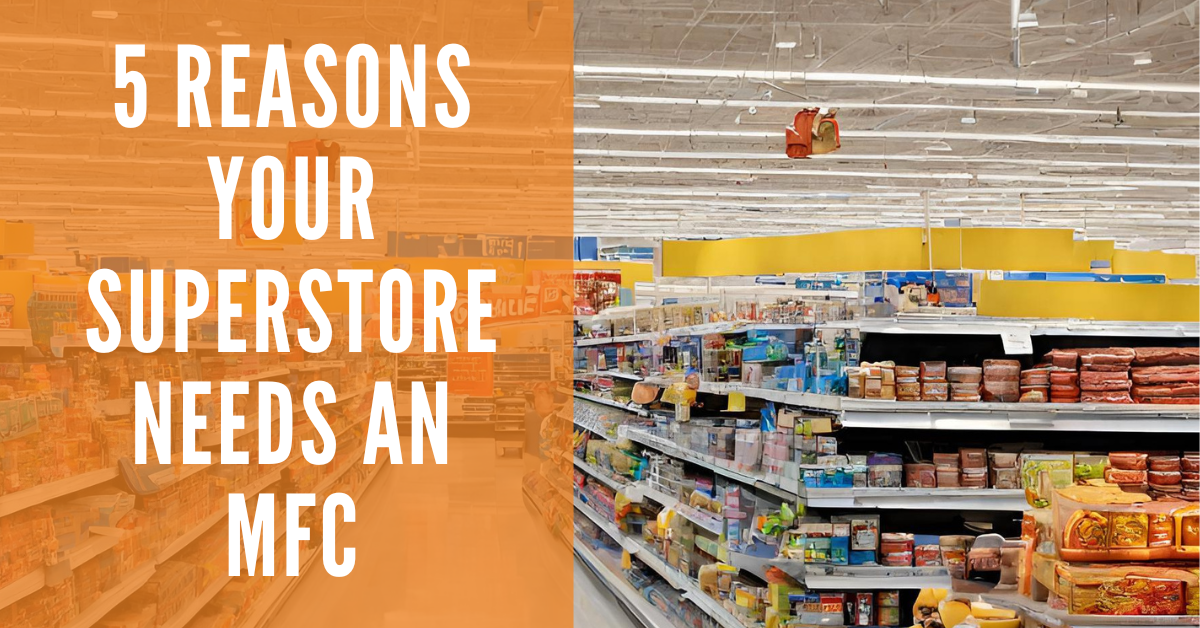


The modern consumer demands an unprecedented level of agility and speed, surpassing the fulfillment capabilities of typical distribution centers. With 90% of customers considering two to three-day delivery to be the baseline expectation, many superstores are building faster delivery models.
Microfulfillment centers (MFCs) are a solution that enables big-box retailers to serve customers directly and quickly fulfill different order types, such as buy online, pickup in store (BOPIS), ship-from-store and same-day delivery. They offer a way for retailers to quite literally get closer to their customers while alleviating storage challenges and improving SLA performance. Plus, in most cases, idle or closed store space can be converted into these last-mile fulfillment nodes in less than 12 weeks. In this blog post, we delve into the transformative potential of superstore microfulfillment centers and how they can reshape the future of retail.
Idle or closed store space can be converted into a microfulfillment center in less than 12 weeks.
Retail success in the digital age hinges on how effectively businesses can bridge the gap between the virtual and physical shopping experiences. Superstore microfulfillment centers present a unique opportunity to create a more personalized and convenient customer journey. Because they are strategically located within or near urban areas (or sometimes within the back stores of existing retail locations) superstores can use these centers to significantly reduce the distance between products and consumers. This proximity translates to faster delivery times and improved last-mile logistics, effectively bringing retailers closer to their customers.
To say that meeting customer expectations for delivery speed and reliability is a common concern for retailers would be an understatement. Due to complex supply chains and extensive delivery networks, traditional fulfillment models often struggle to deliver on these fronts. Superstore microfulfillment centers typically leverage robotics and AI-driven Multiagent Orchestration (MAO) for optimal order processing. MAO can automate and optimize the loading of orders into delivery trucks based on specific routes, easily reconfigure workflows according to changing business needs, maximize cube utilization and effectively utilize vertical space. Plus the compact nature of microfulfillment centers naturally drives more efficient picking, packing and sorting, enabling retailers to achieve tighter SLAs with confidence.
RELATED READ: How microfulfillment centers can enhance warehouse efficiency and reduce carbon emissions
Storage inefficiencies can pose significant challenges that ultimately lead to increased costs and potential stockouts. Superstore MFCs tackle this issue by utilizing vertical storage, robotic automation and smart inventory allocation to maximize space utilization. With space-maximizing designs and intelligent inventory management systems, MFCs can store a diverse range of products while minimizing storage gaps. This leads to better inventory turnover rates, reduced carrying costs and improved overall operational efficiency.
In today’s volatile retail climate, scalability and adaptability are must-haves. Big-box retailers can easily replicate microfulfillment centers across different locations. This allows them to quickly respond to changing consumer demands and market trends. In addition, they can rapidly expand into new markets without the need for extensive infrastructure investments. By strategically placing microfulfillment centers close to their customers, retailers can stay agile and ensure their operations align with shifting customer preferences.
Concerns about job displacement are natural in the age of automation. However, superstore microfulfillment centers are typically not replacing human workers but promoting human-robot collaboration. Employees can focus on tasks that require creativity, problem-solving and customer interaction while robots handle the repetitive and labor-intensive aspects of order fulfillment. This not only enhances job satisfaction but also elevates the overall shopping experience for customers.
Microfulfillment centers stand at the intersection of customer-centric retail strategies and operational excellence. By enabling retailers to get closer to their customers while closing SLA and storage gaps, superstore MFCs are redefining the future of retail. With its potential to transform the supply chain landscape, the microfulfillment market is projected to grow 2x by 2025 and 12x by 2030. Embracing this innovative approach can lead to enhanced customer loyalty, optimized operations and sustained growth in the competitive world of retail.
Curious about whether or not your fulfillment operations could benefit from an automated MFC? Try our MFC ROI calculator to find out >>